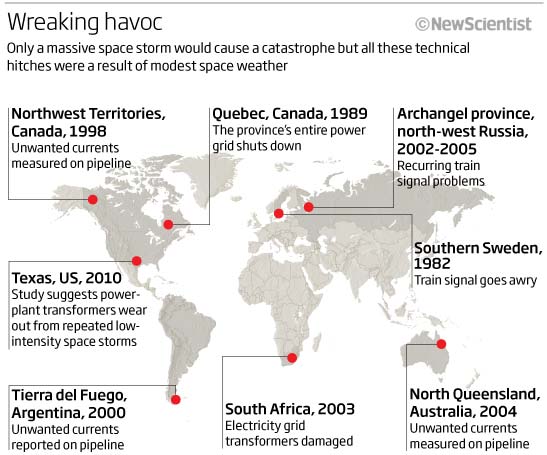
© NASATrouble ahead
Ever think to check the space weather forecast? Power suppliers and the operators of oil pipelines and railroads might want to start.
Although it would take a
truly massive space storm to cause a catastrophe, it is becoming clear that even modest solar activity poses a threat in our technology-dependent world. It makes railway signals go haywire and rusts oil pipelines to the point that they may leak, not to mention wearing down key components in power grids, which could drive up the cost of electricity.
If our planet happens to be in the line of fire when the sun belches out clouds of plasma, these coronal mass ejections (CMEs), can greatly disturb Earth's magnetic field. Such magnetic disturbances in turn can generate currents in power transmission lines, which act like giant antennas to pick up the disturbances.
Relatively minor space storms now appear to be behind a range of mysterious mishaps - railway signals malfunctioning in Archangel province in north-western Russia, for example, between 2000 and 2005. A study led by Eugenia Eroshenko of the
Pushkov Institute of Terrestrial Magnetism, Ionosphere and Radio Wave Propagation in Troitsk, Russia, examined episodes when signals turned red for minutes or even hours though the track ahead was clear, then spontaneously reverted to green.
Eroshenko's team found that 16 malfunctions of this sort observed between 2000 and 2005 coincided with space storms (
Advances in Space Research, DOI: 10.1016/j.asr.2010.05.017). "We were surprised by such a clear correlation," Eroshenko says.
How could space weather switch railroad signals from green to red? CMEs appear to interfere with circuits used to sense whether a segment of track is occupied. A power source connected to the two rails normally maintains a voltage between them while they are unoccupied. When a train is present, it eliminates the potential energy difference between the rails by allowing electricity to flow from one to the other. Space storms may have the same effect on the rails as a train, generating unwanted electric currents that could cause the voltage between the two rails to drop and the signal to turn red.
The parts of the Russian railway studied by Eroshenko's team might be especially vulnerable to space weather because they are in the far north, and solar storms are most intense around the poles.
Team member Risto Pirjola of the
Finnish Meteorological Institute in Helsinki thinks that if other countries start examining the timing of unexplained signal problems, they may turn up a similar link to space weather. The evidence of a link to space storms is "very convincing", says Rod Perala of
Electro Magnetic Applications, a consultancy in Lakewood, Colorado, that studies the effects of space weather. It would be wise for railways in other countries to check their equipment for vulnerability to space weather, too, he says.
It should be possible to modify railways to prevent these problems. Some sections seem immune to space weather, perhaps because of minor differences in electrical hardware, and the parts used in the problem-prone areas could be changed, Eroshenko says, but funds have been lacking.
Space weather may also make oil and gas pipelines more prone to rusting - a particular concern because rusty pipelines sometimes spring leaks, creating costly and environmentally damaging spills.
The chemical reactions that cause rust require electrons to flow from the pipe into the surrounding soil, so one way to keep corrosion at bay is to create a potential energy barrier that impedes this flow of electrons, using a power source attached to the pipe. Space storms, however, generate currents in pipes that can overwhelm this barrier, allowing corrosion to proceed.

© New Scientist
Engineers have measured such currents, though no one has yet quantified how much these flows increase corrosion. "That's much harder to estimate because it's a long, slow process and it depends on a host of other factors" like soil composition and moisture, says
David Boteler of the Geological Survey of Canada's Geomagnetic Laboratory in Ottawa.
The worry is that corrosion induced by space weather may reduce the useful lifetime of the pipes, which in turn means they require early replacement. This could be a very costly problem, if for example it cuts the lifetime of a pipeline from an expected 60 years to 30, given the great expense of building new ones, Boteler says. And the effects on pipelines may be worldwide.
Richard Marshall of the
Australian Bureau of Meteorology's space weather unit found that space storms disrupted voltages in pipelines in northern Australia, which is just 20 degrees from the equator (
Space Weather, DOI: 10.1029/2009SW000553).
"Geomagnetic effects are becoming an issue that must be considered for pipelines at all latitudes," says Boteler.
Subtle effects of run-of-the-mill space storms may also wear down key components in electric power grids, making them liable to early failure.
Space storms cause currents to flow in electrical transformers, which are used to boost the voltage of electrical flows to the high levels needed for efficient long-distance transmission and then back down again for safe use by consumers at the delivery point. Intense power surges due to big space storms can heat transformers enough within minutes to damage the insulation needed to prevent short circuits, which can cause them to explode.
More recently, there are signs that transformers can be destroyed by smaller currents over a period of hours or more. A long-lasting 2003 space storm delivered only relatively low-intensity currents to the South African power grid, but damaged several transformers anyway, notes US-based storm analysis consultant John Kappenman.
Kappenman
raised concerns about low-intensity storms at a conference in March in Dallas, Texas, organised by the
North American Electric Reliability Corporation. Small insults from numerous storms may accumulate over a period of years, causing transformers to fail, he says. The number of transformer failures in the US seems to mirror the 11-year rise and fall of the solar cycle, which governs the frequency of space storms, in data Kappenman presented at the conference.
The cost of replacing transformers gets passed on to consumers, though Kappenman says it is unlikely to account for more than a few per cent of the total cost of electricity. Still, the problem is pervasive. "Arguably every transformer that's out there has been exposed to some degree to this problem."
Lanzerotti emphasises the importance of such cumulative effects. "The big [storms] are so dramatic that people pay most attention to them," he says, "but I do think these cumulative types of effects deserve more attention."
Reader Comments
to our Newsletter